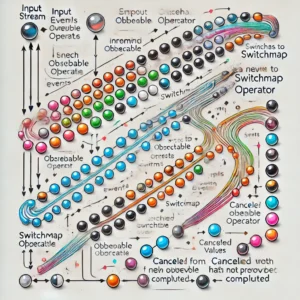Microservices architecture is a software development approach that has gained popularity in recent years. It involves building applications as a collection of small, independent services that communicate with each other through APIs. This approach is designed to make it easier to develop, test, deploy, and scale applications, as well as to improve their resilience and maintainability.
In a microservices architecture, each service is developed and deployed independently of the others, allowing for greater flexibility and agility. This makes it possible to update or replace individual services without affecting the rest of the application. Microservices also enable developers to use different programming languages and technologies for each service, depending on the specific requirements of that service.
Implementing a microservices architecture can be a complex undertaking, requiring careful planning and design. However, the benefits of this approach can be significant, including improved scalability, resilience, and agility. In the following sections, we will explore the key concepts and best practices for building microservices-based applications, including how to design, develop, deploy, and manage them effectively.
Understanding Microservices
Microservices are an architectural style used for developing applications. In this style, applications are built as a collection of small, independent, and loosely coupled services. Each service is responsible for a specific task or functionality, and they communicate with each other over a network using lightweight protocols.
The microservices architecture is an evolution of the traditional monolithic architecture, where a single application is built as a single unit. In contrast, the microservices architecture breaks down the application into smaller, more manageable pieces. This approach offers several benefits, including:
- Scalability: Microservices can be scaled independently of each other, allowing for better resource utilization and improved performance.
- Resilience: If one service fails, it does not affect the other services, and the application can continue functioning.
- Flexibility: Microservices can be developed and deployed independently, allowing for faster development and deployment cycles.
- Technology diversity: Each service can be developed using a different technology stack, allowing for greater flexibility and innovation.
However, the microservices architecture also presents some challenges, such as:
- Complexity: Managing and coordinating multiple services can be complex, requiring additional tools and processes.
- Distributed systems: The microservices architecture relies on network communication between services, which can introduce latency and other issues.
- Testing: Testing microservices can be challenging, as each service must be tested independently and as part of the larger application.
Overall, the microservices architecture offers a modern and flexible approach to application development. By breaking down applications into smaller, independent services, developers can build more scalable, resilient, and flexible applications.
Benefits and Challenges of Microservices
Microservices architecture is becoming increasingly popular in the software development industry due to its numerous benefits. However, it also presents some challenges that need to be considered before implementing it.
Benefits of Microservices
Independent Development and Deployment
One of the primary benefits of microservices architecture is that each service can be developed and deployed independently. This allows for faster development and easier bug fixing, as small teams can take responsibility for building, testing, and deploying each service.
Scalability and Flexibility
Microservices architecture allows for the scaling of individual services based on their specific needs. This means that resources can be allocated more efficiently, resulting in better performance and cost savings. Additionally, microservices can be designed to use different technologies, allowing for greater flexibility in the development process.
Resilience and Fault Isolation
Microservices architecture promotes fault isolation, meaning that if one service fails, it does not affect the entire system. This makes it easier to identify and fix issues, resulting in increased system resilience and availability.
Challenges of Microservices
Complexity and Management
Microservices architecture can be more complex to manage than traditional monolithic architecture. Each service needs to be monitored, tested, and deployed independently, which can be time-consuming and require additional resources. Additionally, communication between services can be challenging, requiring careful planning and management.
Distributed Systems and Integration
Microservices architecture relies on distributed systems, which can introduce additional complexities in terms of integration and communication. Services need to be designed to work together seamlessly, which can require additional development effort and careful coordination.
Testing and Debugging
With microservices architecture, testing and debugging can be more challenging, as each service needs to be tested independently. Additionally, issues can arise when services are updated or changed, requiring careful coordination and testing to ensure that the entire system continues to function correctly.
In conclusion, while microservices architecture offers numerous benefits, it also presents some challenges that need to be considered before implementation. Proper planning, management, and testing can help mitigate these challenges and ensure the success of a microservices-based system.
Key Components of Microservices Architecture
Microservices architecture is a popular approach to building software applications that are scalable, resilient, and easy to maintain. In this section, we will discuss the key components of microservices architecture.
Service Components
The microservices architecture is based on the concept of breaking down an application into smaller, independent services. Each service performs a specific function and can be developed, deployed, and scaled independently. Services communicate with each other using lightweight protocols such as REST or messaging systems like RabbitMQ.
To ensure that services can be developed and deployed independently, they should have well-defined boundaries and interfaces. This allows developers to make changes to a service without affecting other services in the system.
Database Per Service
In a microservices architecture, each service should have its own database. This ensures that services are loosely coupled and can be scaled independently. It also allows each service to choose the most appropriate database technology for its specific needs.
Having a separate database per service also makes it easier to maintain data consistency and integrity. Each service is responsible for its own data, and changes to one service’s data do not affect other services in the system.
API Gateway
An API gateway is a key component of a microservices architecture. It acts as a single entry point for all client requests and routes them to the appropriate service. The API gateway also handles authentication, rate limiting, and other cross-cutting concerns.
Using an API gateway makes it easier to manage and monitor the microservices architecture. It provides a centralized location for logging and monitoring, and allows for easier debugging and troubleshooting.
In summary, the key components of microservices architecture are service components, database per service, and API gateway. By breaking down an application into smaller, independent services, microservices architecture makes it easier to build and maintain scalable, resilient, and highly available applications.
Microservices Communication Patterns
Microservices architecture is based on the idea of building small, independent services that communicate with each other to form a larger application. Communication between microservices is critical to ensure that the system works as a whole. There are two main types of communication patterns in microservices architecture: synchronous and asynchronous.
Synchronous Communication
Synchronous communication is when a microservice sends a request to another microservice and waits for a response before continuing. This type of communication is useful when the response is required immediately, and the calling service cannot continue without it. Synchronous communication can be implemented using REST APIs, gRPC, or other similar protocols.
One of the benefits of synchronous communication is that it is easy to implement and understand. Developers can use familiar tools and technologies to build synchronous communication between microservices. However, synchronous communication can also introduce latency and reduce the overall performance of the system. If one service becomes slow or unresponsive, it can cause a ripple effect that affects other services.
Asynchronous Communication
Asynchronous communication is when a microservice sends a message to another microservice without waiting for a response. This type of communication is useful when the response is not required immediately, and the calling service can continue without it. Asynchronous communication can be implemented using message queues, event-driven architecture, or other similar patterns.
One of the benefits of asynchronous communication is that it can improve the overall performance and scalability of the system. Services can process messages in parallel, and the system can handle spikes in traffic more effectively. However, asynchronous communication can also be more complex to implement and debug. Developers need to consider issues such as message ordering, duplicate messages, and error handling.
In conclusion, both synchronous and asynchronous communication patterns have their advantages and disadvantages. The choice of communication pattern depends on the specific requirements of the system. Developers need to consider factors such as performance, scalability, reliability, and complexity when designing the communication between microservices.
Implementing Microservices
Microservices architecture is a popular approach to building complex applications that are scalable, resilient, and easy to maintain. In this section, we will discuss the implementation of microservices, including development, deployment, and monitoring.
Microservices Development
Developing microservices requires a different approach than traditional monolithic applications. Each microservice should be developed independently, with a small team responsible for its development, testing, and deployment. This approach enables faster development, easier bug fixing, and faster feature releases.
To develop microservices, developers should follow a few best practices, including:
- Using lightweight frameworks and libraries
- Building services around business capabilities
- Designing for failure and resilience
- Using event-driven architecture
- Ensuring data consistency across services
Microservices Deployment
Deploying microservices is a critical part of the implementation process. Each microservice should be deployed independently, with its own infrastructure and resources. This approach enables easier scaling, fault isolation, and faster deployment.
To deploy microservices, developers should follow a few best practices, including:
- Using containerization technologies like Docker
- Using a container orchestration platform like Kubernetes
- Using a service mesh for service-to-service communication
- Ensuring high availability and fault tolerance
- Using blue-green or canary deployments for zero-downtime releases
Microservices Monitoring
Monitoring microservices is essential for ensuring their reliability and performance. Developers should monitor each microservice independently, as well as the overall system. This approach enables faster issue detection and resolution, as well as better insights into system behavior.
To monitor microservices, developers should follow a few best practices, including:
- Using a distributed tracing system like Jaeger or Zipkin
- Using a logging system like ELK or Splunk
- Using a metrics system like Prometheus or Grafana
- Setting up alerts for critical events and thresholds
- Conducting regular performance testing and optimization
In conclusion, implementing microservices requires a different approach than traditional monolithic applications. Developers should follow best practices for development, deployment, and monitoring to ensure the reliability, scalability, and performance of their microservices architecture.
Case Studies in Microservices Implementation
Microservices architecture has been adopted by many companies to improve their application development process. Here are two case studies on how Netflix and Amazon have implemented microservices architecture successfully.
Netflix
Netflix is a popular streaming service that uses microservices architecture to deliver content to its customers. The company has over 100 million subscribers worldwide, and its microservices architecture allows it to handle the large volume of requests it receives.
Netflix’s microservices architecture is based on the following principles:
- Each service should be small and focused on a specific task.
- Services should communicate through APIs.
- Services should be stateless.
- Services should be independently deployable.
Netflix uses a variety of open source technologies to implement its microservices architecture, including Apache Cassandra, Apache Kafka, and Apache ZooKeeper. The company also uses its own tools, such as the Netflix Conductor orchestration engine, to manage its microservices.
Amazon
Amazon is another company that has successfully implemented microservices architecture. The company’s e-commerce platform is built on a microservices architecture that allows it to handle the large volume of requests it receives.
Amazon’s microservices architecture is based on the following principles:
- Services should be small and focused on a specific task.
- Services should communicate through APIs.
- Services should be loosely coupled.
- Services should be independently deployable.
Amazon uses a variety of technologies to implement its microservices architecture, including Amazon EC2, Amazon S3, and Amazon DynamoDB. The company also uses its own tools, such as the Amazon Elastic Container Service (ECS), to manage its microservices.
In conclusion, both Netflix and Amazon have successfully implemented microservices architecture to improve their application development process. By following the principles of microservices architecture, these companies have been able to handle large volumes of requests and improve the overall performance of their applications.
Future Trends in Microservices
Microservices architecture has been gaining popularity in recent years, and it is expected to continue to grow in the future. Here are some of the expected trends in microservices:
1. Increased adoption of serverless computing
Serverless computing is an architecture where the cloud provider manages the infrastructure and automatically allocates resources as needed. This architecture is highly scalable, cost-effective, and allows for faster development and deployment of microservices. As a result, it is expected that more organizations will adopt serverless computing in the future.
2. Greater use of containerization
Containerization is a method of packaging an application and its dependencies into a single container that can be run on any platform. Containers are lightweight, portable, and provide a consistent environment for microservices to run. With the increasing popularity of containerization technologies like Docker and Kubernetes, it is expected that more organizations will adopt containerization for deploying microservices.
3. Increased use of AI and machine learning
Artificial intelligence (AI) and machine learning (ML) are technologies that can be used to improve the performance and scalability of microservices. For example, ML can be used to optimize resource allocation and predict failures, while AI can be used to automate the deployment and scaling of microservices. As these technologies continue to mature, it is expected that more organizations will adopt them for microservices deployment.
4. Growing importance of security
As microservices architecture becomes more popular, security becomes an increasingly important concern. Microservices are typically distributed across multiple servers and communication between them needs to be secure. It is expected that in the future, there will be a greater emphasis on securing microservices through the use of encryption, authentication, and other security measures.
In conclusion, the future of microservices architecture is bright, with increasing adoption of serverless computing, containerization, AI and machine learning, and greater emphasis on security. These trends are expected to lead to more efficient, scalable, and secure microservices deployments in the future.






